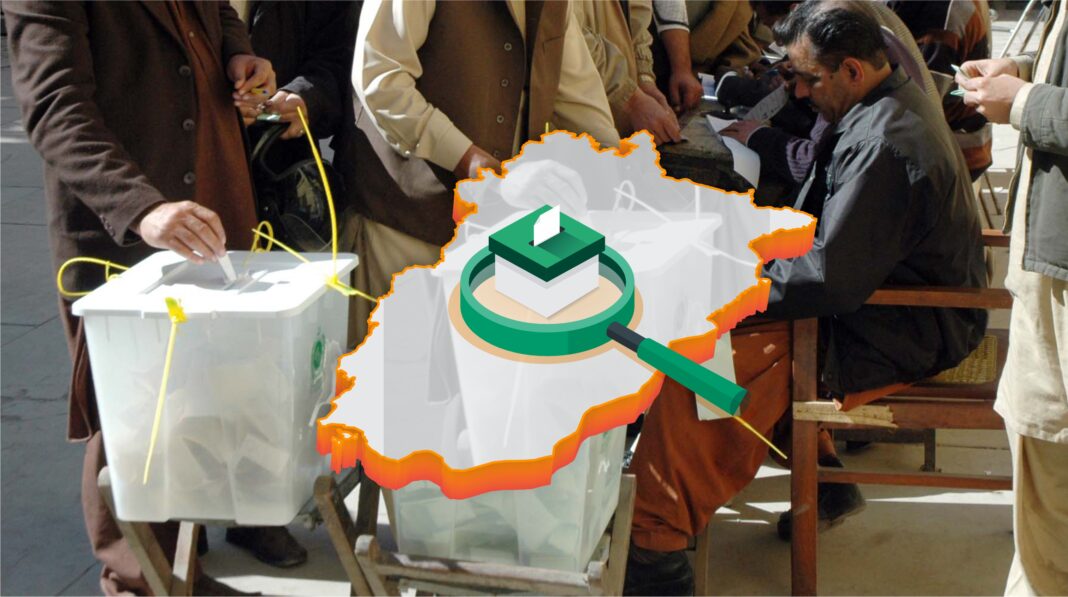By-elections for 20 Punjab Assembly seats generated a deep interest for voters as well as candidates. FAFEN catches the essence.
An impressive 49.7 percent turnout in the by-elections for 20 Punjab Assembly seats on July 17, 2022 augurs well for an otherwise struggling democracy in Pakistan. The election day remained largely orderly and well-managed, though reports of isolated incidents of brawls and fights, some of them overplayed by media, particularly the social media, tainted the perception of quality of electoral exercise that, however, culminated with a rare acceptance of defeat by Pakistan Muslim League – Nawaz (PML-N), a gesture that can set the stage for a thriving democracy in the country.
By-Elections for 20 Punjab Assembly Seats: Result & Allegations
Pakistan Tehreek-i-Insaf (PTI) emerged victorious on 15 of the 20 seats, which were vacated after its members were disqualified for voting against their party’s directions in the election for the Chief Minister (CM) of Punjab. PTI lost four constituencies to PML-N candidates and one to an independent candidate.
The party had alleged foul play since the outset of the by-election process and leveled allegations of partisanship against the Election Commission as well as other government institutions. Considering the gravity of these allegations, an independent probe through a specially formed parliamentary committee comprising representatives of all parties may be instituted to ascertain their veracity or otherwise. In addition to contributing to the ongoing electoral reform process, a conclusive probe will strengthen the integrity of future elections.
By-Elections for 20 Punjab Assembly Seats: The Need for Better Monitoring
Amongst several positives, the by-elections are instructive for the Election Commission of Pakistan (ECP) and other stakeholders to pay more attention to curbing the increasingly polarizing tactics and content of party campaigns both before and on the election day not only through traditional mechanisms but also social media. The by-elections reinforced the need for a proper monitoring and enforcement mechanism to ensure compliance with the Code of Conduct for Parties and Candidates and check any misuse of government resources, and alleged cases of vote-buying and other inducements through tightening the laws, rules, and limits for election expenses. In addition, to improve the election environment, a stricter legal regime must be introduced to discourage unsubstantiated allegations, insinuations, and accusations.
The ECP ensured appreciable improvements in polling, counting, and result-management processes, particularly by making sure that preliminary results of all constituencies, except for the one in Rawalpindi (PP-7), were promptly released. This ensured greater public confidence in the election outcome and also preempted the escalation of political temperatures that generally arise as a result of delayed results.
Election Day Violations & ECP Role
However, the ECP’s enforcement remained weak for curtailing the campaigning and canvassing on election day through electronic media and social media primarily due to inadequate legal and regulatory provisions. ECP’s instructions to media on election coverage were largely circumvented, with political leaders from contesting parties canvassing for votes in their media appearances on election day. Instructions for the telecast of polling stations-wise results were also not completely adhered to.
While these practices outside polling stations were also observed, contesting candidates in several constituencies also employed newer ways to woo voters such as rallies and gatherings away from the legally-barred limits around polling stations. The election law needs to be reinforced to curb such practices in future elections. One way to address such situations is to introduce effective checks on the use of money, which currently are inadequate, cosmetic, and weak. Unless campaign finance rules are tightened, a level playing field will be difficult to be maintained for all candidates and political parties.
By-Elections for 20 Punjab Assembly Seats: An Unusual Affair
The by-elections were among the most hotly contested elections in recent times. The number of contestants dropped from 234 candidates (226 men and eight women) who contested in General Elections (GE) 2018 to 175 candidates (170 men and five women) for the 2022 by-elections. As many as 4,579,898 voters were registered to vote in these constituencies as compared to 3,842,368 in 2018. Among men voters, the turnout was 53 percent compared to 60.6 percent in GE-2018. Women’s turnout was recorded at 45.5 percent – relatively lower compared to 54 percent in GE-2018. Over 60,000 more voters cast their votes in these by-elections as compared to their number in 2018, of which more than half (37,271) were women.
The Free and Fair Election Network (FAFEN) deployed 203 election-day observers – 109 men and 94 women – to observe the voting and counting processes at 800 polling stations in all 20 constituencies. The observers were trained on the Elections Act, 2017, and the codes of conduct of the relevant stakeholders to observe the proceedings effectively and independently. FAFEN observers were also provided standardized checklists to record their observations. Each observer was assigned four polling stations: in the first polling station, they were tasked to observe the processes preceding the start of polling, at the second and third they observed the voting processes, and at their fourth polling station, in addition to the voting process, they observed the closing and counting processes. FAFEN observers were not allowed to ask voters about their voting choices inside or outside polling stations as it is strictly prohibited under the ECP’s Code of Conduct for Observers and as per Section 178 (b) of the Elections Act, 2017.
This report is based on the observations received on election day from 638 polling stations from all 20 constituencies obtained by FAFEN observers through a specially-established call center as well as through real-time reporting using mobile and web-based applications. The data, once received, was cleaned and where necessary, verified, before being subjected to analysis.
To download the report, click here


